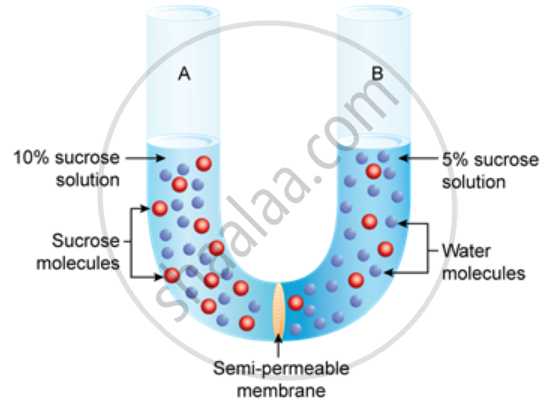Advertisements
Advertisements
Question
The figure given below is a diagrammatic representation of a part of the cross-section of the root in the root hair zone. Study the same and then answer the questions that follow :
(i) Name the parts indicated by guidelines ‘1’ to ‘5’
(ii) Is the root hair cell unicellular or multi-cellular?
(iii) Draw a labeled diagram of the root hair cell as it would appear if some fertilizer is added to the soil close to it.
(iv) Name the process responsible for the entry of water molecules from the soil into A1 and then A2.
(v) What pressure is responsible for the movement of water in the direction indicated by arrows?
(vi) How is this pressure set up?
Solution
(i) 1. Vacuole (containing cell sap)
2. Soil particles
3. Xylem vessel
4. Cortex cells
5. Vacuole in cortical cells
(ii) Root hair cell is unicellular
(iii) See diagram alongside.
(iv) Osmosis
(v) Osmotic pressure
(vi) This pressure is set up due to the difference in osmotic gradient.
APPEARS IN
RELATED QUESTIONS
State whether the following statement is true or false. Rewrite the false statement correctly.
Water absorption mainly occurs through the root-hair.
Explain why:
Raisins swell up in water.
Choose the correct answer:
Process of ascent of sap in plants occurs ___________
Study the experimental setup in the figure and then answer the question that follow.

Explain the phenomenon mention in question 8.1 .
Grapes shrink when immersed in a very strong sugar solution.” Explain.
Given below is the diagram of a cell as seen under the microscope after having been placed in a solution:

(i) What is the technical term used for the state/condition of the cell given above?
(ii) Give the technical term for the solution in which the cell was placed.
(iii) Name the parts numbered 1 to 4.
(iv) Is the cell given above a plant cell or an animal cell ? Give two reasons in support of your answer as evident from the diagram.
(v) What would you do to bring this cell back to its original condition?
________ type of tissues are present in epiphytic roots.
Write a note on the morphological structure of the root.
____________ regions are present in a typical root.
Give other name of epidermal cells in roots of plants.
